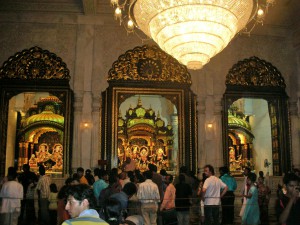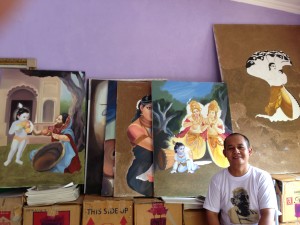HG Narottamananda Prabhu / Bhagavad-gita As It Is 10
HH Guru Prasad Swami / SB 10.45.35-36
→ Kalachandji's Audio Archive
HH Keśava Bharati Dāsa Goswami / NAVA VRAJA MAHIMA
→ Kalachandji's Audio Archive
HG Rupanuga Prabhu / SB 10.45.29
→ Kalachandji's Audio Archive
H.H. Keśava Bhāratī Dāsa Goswami / SB 10.45.26-28
→ Kalachandji's Audio Archive
Nityananda Chandra Prabhu / Is Being Vegetarian Necessary for Spiritual Life / The Darshan Room – 6/26
→ Kalachandji's Audio Archive
HG Acyuta Govinda Prabhu / SB 10.45.24-25
→ Kalachandji's Audio Archive
HG Balaram Prasad Prabhu / SB 10.45.15-16
→ Kalachandji's Audio Archive
Kirtan for Lord Jaganath at the Hunstville Jaganath temple
→ Dandavats.com
Clinical Chaplaincy graduation
→ Dandavats.com
 46 HR photos: For the first time in ISKCON - UK Clinical Chaplaincy graduation Read more ›
46 HR photos: For the first time in ISKCON - UK Clinical Chaplaincy graduation Read more › ISKCON launched into the UK NHS
→ Dandavats.com
Become Fortunate
→ travelingmonk.com
Bill Clinton Explains Why He Became a Vegan
→ Dandavats.com
What You Need to Know About the Hare Krishnas
→ Dandavats.com
Sugam Karnatica Kids have Fun at the Farm
→ ISKCON Malaysia
BY GOKUL DAMODARA DASA
JANDA BAIK - A total of 80 kids of Sugam Karnatica’s Sunday School gathered excitedly at 8.00 a.m on 28th July 2013 at the Taman Jaya carpark to make our way to the HareKrishna Goshala (cow- farm) located at Janda Baik, Pahang. The kids, accompanied by facilitators of Sugam Karnatica and parents boarded 2 buses which had been chartered to take us there.The bus left at 8.30am and we reached Janda Baik at about 10.00 a.m. The bus had to stop along the mainroad and we had to walk along a narrow road for about 3 kilometres before we reached the farm.
When we reached, we were briefed by Goloka Prabhu of ISKCON Malaysia, which is the body that runs and operates the farm. We also had a short video presentation and briefing by Goloka Prabhu, where he explained how an entire community lived on a farm in Hungary. The video showed us how the people there live with natural resources, yet they are fully equipped with all facilities such as schools and other amenities.
After that, we joined in a bhajan chanting session led by the devotees of ISKCON Malaysia. During the bhajan, we were treated to ‘Bliss Bars’ – sweet white and brown chocolate bars made from pure unadulterated cow’s milk! Yummy!
Soon after, it was time to bathe and feed the cows. The group was broken into two and took turns bathing and feeding the cows. We used a hose to spray water on the cows and brushes to brush their coats.
As for feeding, the cows were fed with grass and brown sugar, which they truly relished! It was fun feeding the cows, especially feeling the rough surface of the cow’s tongue on our palms. An experience to remember!
The children also took the opportunity to stroke and pet the cows. It was a wonderful hands-on experience for all the kids, and for most of them, this was the first time in contact with a real life cow.
By noon, everyone was exhausted and hungry and treated to wonderful prasada.
Then it was time for some pop quiz. Many students were successful in answering the questions posed and won Krishna and Shiva masks!
This was followed by a presentation of cheque of RM1000 to the Hare Krishna Goshala, contributed by all Sugam Sunday School students. Very soon, it was time to say goodbye to the cows and the lovely people at the Hare Krishna farm, but not before we had a round of extremely yummy fresh ice cream made from cow’s milk in various flavors – strawberry, green apple and chocolate. All in all, we had a fun and enjoyable time while learning more about Mother Cow.

Thank you Sugam Sunday School and ISKCON Malaysia! Till the next field trip! Hare Krishna
Why Srila Prabhupada subtitled Bhagavad-gita “As It Is” (Part 2)
→ SivaramaSwami.com
Evening program in Budapest.
PlanetISKCON.com 2.0 Launched
→ Dandavats.com
Amoga Lila Preaching In Pakistan
→ Dandavats.com
 4 pics: Amoga Lila Preaching In Pakistan Read more ›
4 pics: Amoga Lila Preaching In Pakistan Read more › Test Hare Krishna
→ The Spiritual Scientist
tttt
Gaura Mani Leads During New Vrindaban’s 24 Hour Kirtan – June 15th, 2013
→ New Vrindaban Brijabasi Spirit
Video of Gaura Mani Dasi leading during New Vrindaban’s 24 Hour Kirtan - June 15th, 2013. Thanks to Bhakta Vatsala Dasa for posting on Youtube.
Most High – Music Video (Sri Isopanisad Mantra One)
→ Dandavats.com
 4 min vid: Most High - Music Video (Sri Isopanisad Mantra One) Read more ›
4 min vid: Most High - Music Video (Sri Isopanisad Mantra One) Read more › Festival of the Chariots 2013 in Los Angeles
→ Dandavats.com
 130 beautiful, HR, downloadable photos from the Festival of the Chariots 2013 in Los Angeles, US Read more ›
130 beautiful, HR, downloadable photos from the Festival of the Chariots 2013 in Los Angeles, US Read more › Food for Thought
→ Mahavishnu Swami
Bhakti Caitanya Swami @ Vaishnava summer festival BALTIC 2013
→ Gouranga TV - The Hare Krishna video collection
Bhakti Caitanya Swami @ Vaishnava summer festival BALTIC 2013
Holy Name EXPLOSION in Pula
→ Dandavats.com
 61 pics: Holy Name EXPLOSION in Pula. Dear Friends, our walking harinam in Pula was a full success Read more ›
61 pics: Holy Name EXPLOSION in Pula. Dear Friends, our walking harinam in Pula was a full success Read more › What does the Gita say about love and inter-caste marriages?
→ The Spiritual Scientist
From: Kaushik
What does Gita says on Love? What if we love someone dearly but they are not with us for some ills of our society? Also, what has Gita said for marriages in such cases?
Why does the Krishna book publically present confidential tenth canto pastimes?
→ The Spiritual Scientist
07.09 – Rise from “willpower is power” to “willpower is his power”
→ The Spiritual Scientist
We all need willpower for doing anything worthwhile. In fact, willpower is the power that unleashes our other powers such as undeveloped talents. Without willpower, potential geniuses end up becoming prodigals instead of prodigies.
Strong willpower is a great power to have, but it’s not all that great if it’s divorced from spiritual reality. Let’s understand how.
Gita wisdom offers us a vivid vision of spiritual reality. We are all souls, parts of Krishna. All our abilities come from him – even our willpower, as the Bhagavad-gita (07.09) indicates. We can glimpse this truth when the willpower we think is ours sometimes suddenly deserts us, leaving us struggling to do the things that we normally do effortlessly.
As long as we think that willpower is our power, we labor under the illusion that doing the things that we want to do will make us happy. But we as souls can't be satisfied by anything except spiritual love for Krishna. We keep erecting new goals and maybe even attaining them, but happiness keeps eluding us. Still, our willpower intoxicates us with vanity, making us pretend to be happy at our achievements or making us believe that the next achievement will make us happy.
To end this vain intoxication, we need to see willpower not as our power but as Krishna’s power. This vision inspires us to surrender to Krishna and use all our willpower to serve him single-mindedly. Such service wins his heart, and he grants the supreme power of love for him. When we are animated and guided by the power of love for Krishna, our willpower enables us to do wonderful things in his service. These devotional achievements enrich and flavor our love for Krishna, thereby propelling us towards an everlasting life of love with him.
**
I am the penances of all ascetics.
A Few Words Related to “Falldowns” of “Swamis” and “Gurus”
→ The Enquirer
Everyone falls down. Gurus fall down, nobodies fall down. Men fall down, women fall down. Old people fall down, young people fall down. People who write books fall down, people who never say a single word fall down. People who practice rāgānugā-sādhana fall down, people who practice vaidhi-sādhana fall down. Brahmacaris fall down, grhasthas too, sanyassis too, and “that other āśrama” as well; even those who are uncultured on both ends of the spectrum fall down. People who travel and preach fall down, people who stay in one place fall down. People in Vrndavana fall down, people in Govardhan fall down, people in Radha Kunda fall down, and people in Nebraska fall down too.
The purusha abhiman can regain its beginningless hold over the miniscule jiva at any point in time, anywhere, under any circumstances. I don’t think its profitable to overanalyze the circumstances, therefore, pretending that the circumstances cause the falldown. It is the purusha-abhiman which causes the fall down, the circumstances it exploits to do so can be anything.
The best advice is therefore to continually try our best to always do Harinam-Samkirtana; not feeling respectable, but always feeling respectful; very meek like grass, and very patient like trees.
Causeless mercy
→ KKS Blog
(Kadamba Kanana Swami, 30 June 2013, Vrndavan, India, Lecture to the kirtan group)
 Krsna is so kind, he gives us the spiritual world. I often think about that. Krsna thought to himself:
Krsna is so kind, he gives us the spiritual world. I often think about that. Krsna thought to himself:
“Oh, there are those living beings who have turned away from me. Things are not complete without them. Let me do something for them. Let me give them some mercy. But why would I give them only some mercy? Why don’t I just give them all the mercy? Why would I hold back and give them only some? I’ll give them all the mercy!”
And then he placed the spiritual world in the material world. How it mathematically fits, the tripada-vibhuti fits into the eka-pada vibhuti – that I leave to the mathematicians. But Krsna did it, you know. He did it! He put it in! So that is something.
When I think about that, then I know that Krsna is not just supplying us with mercy in reciprocation for our service but even causeless mercy.
Misdirected interest is sign of disease
→ The Spiritual Scientist
When a man in the material world takes more interest in the materialistic way of life than in Krishna consciousness, he is considered to be in a diseased condition.
You Must Reform
→ Japa Group

"Japa is an important part of devotional life. If your japa is not up to standard, this is serious. You must reform. That is, out of your regret may come success. Prabhupada used to say, ‘Failure is the pillar of success.’ Assess yourself, and try to improve your chanting of Hare Krishna."
From Japa Reform Notebook
by Satsvarupa dasa Goswami
Jakarta
→ Ramai Swami
Vyasapuja das from Jakarta manages the affairs of the Indonesia BBT. He told me that recently he printed ten thousand Bhagavad-gitas and twenty thousand small books like Chant and be Happy and Coming Back.
path to freedom
→ everyday gita
"Stop the world, I want to get off!" It's a thought that crosses my mind often. Normally this occurs when I'm experiencing a sense of frustration and disappointment with living life in this material world. To all those who are trying to practice the path of bhakti yoga, a word to the wise. Don't despair when encountering this since it can actually help you!
Although bhakti is about experiencing the positive, in order to do so, we must leave those things that hinder us behind.
Or in other words, the loss and emptiness that we may experience actually serves to help us if we look deeper than what meets the eye or emotion. It signifies that we deserve more than what this material world promises us and that we are the proverbial fish out of water.
We are eternal beings who are sojourning through this world. The soul is seeking permanency and shelter - a true home. Encased in this material body, we try to do our best to make our bodies our home to no avail. After all, ever body undergoes birth, death, disease and old age. So how does one get out and find their true home?
This verse gives the yoga seeker the "path to freedom". The Gita is teaching that by understanding the world of transcendence and the soul's connection with the Divine, just by remembering that at the time of death, one escapes the cycle of birth and death. It's a simple as that.
Although it sounds simple, it takes practice. After all, thinking of the Divine isn't as easy as turning a light switch off and on. Our minds are constantly filled with numerous thoughts and often they are the same ones running through over and over and over again. That is why the key practice in bhakti yoga is that of mantra meditation.
Sound has such a powerful effect and by repeating the maha mantra daily, it starts to remove the layers of dust off of our soul. That dust which has accumulated from numerous births is what prevents us from realizing that we are the soul and not this body.
In tandem with practicing mantra meditation, hearing and reading about the Divine fills one's thought with remembrance. By nature we are curious about others and so we can engage that natural propensity to learn more about the one who we've forgotten.
That's why the practice of bhakti yoga is so simple and joyful. It's about engaging our normal tendencies of hearing, talking and remembering and centering it around a focus point: the Divine. Just by doing that, we can leave this world of temporality behind and experience true eternality, knowledge and bliss.
Parenting tip: clean up is million times more fun with kirtan
→ Nityananda Chandra Das' Blog, ISKCON Dallas
Take the Krishna and Leave the Maya, August 4, Carpinteria, California
Giriraj Swami
 A Skype call with devotees in Mumbai.
A Skype call with devotees in Mumbai.
“Srila Prabhupada gave the example of the swan: in a mixture of milk and water, the swan can take out the milk. Similarly, in the material world there is a mixture of Maya and Krishna. We have to extract the Krishna part and leave the Maya part. That is our challenge. But we have good direction in the scriptures, in Srila Prabhupada’s books and in other books coming through the parampara, and we have the association and guidance of more experienced devotees who have gone through many of the challenges we face and can help us pass through them successfully. That is why we are putting so much effort into the Mitra system — so you can get that association and guidance to help you deal with the complexities of the material world, especially in the present age, Kali-yuga, and at the same time encourage you in chanting Hare Krishna, studying Vedic literature, and rendering devotional service.”
Skype talk to Mumbai
Regarding propaganda against animal slaughter in BTG. Please do not print any pi…
→ Mahavishnu Swami
http://prabhupadabooks.com/letters/los_angeles/november/19/1968/rayarama
PrabhupadaBooks.com -- Srila Prabhupada's Original pre-1978 Books Online
prabhupadabooks.com Continue reading
09.14 – Let determination enthrone, not dethrone, devotion
→ The Spiritual Scientist
We may wonder: “Determination requires using our own willpower, whereas devotion requires depending on Krishna’s supreme power. How can we do these two contradictory things simultaneously?”
By seeing our willpower is a means to access Krishna’s supreme power and thereby letting determination enthrone devotion in our heart.
The Bhagavad-gita (09.14) points to this vision when it characterizes serious devotees as having both unflinching determination (yatantash can dridha vratah) and unswerving devotion (namashyantas cha mam bhaktya).
Let’s understand this integration with a treatment metaphor.
When patients are prescribed a demanding treatment plan, they need determination for doing two things. Sticking to those actions that will let the medicine do its work – take bitter pills regularly, for example. And avoiding those actions that will come in the way of the medicine doing its work – abstaining from sweets while being treated for diabetes, for example.
The process of devotional service is essentially a process of spiritual healing, of redirecting our love from the world to Krishna. In this curative process, we need our determination for doing two things. Firstly, for ensuring that we let the process do its work of increasing our attraction to Krishna by being receptive and attentive to the purifying presence of Krishna that we invoke by doing devotional activities like chanting. And secondly for ensuring that we don’t come in the way of the process by avoiding activities that aggravate our infatuation towards worldly things.
If we think that our rigid adherence to rules can makes us spiritually advanced, then determination dethrones devotion from our heart. But if we determinedly follow those rules to please Krishna and beseech him to reveal his all-attractiveness, then determination enthrones devotion in our heart as our supreme hope for happiness and prevents it from being dethroned by all other false hopes.
**
Always chanting My glories, endeavoring with great determination, bowing down before Me, these great souls perpetually worship Me with devotion.
It is GOOD to be a SOUL
→ Krishna Lounge
Sunday, August 4th, 2013
→ The Walking Monk
Pelee Island, Ontario
This area, my childhood playground, you could say, I left forty years ago. South Western Ontario is where life began for me in this body before heading for what seemed to be greener pastures. I pursued studies in college up north, then moved to T Dot (another word for Toronto) the big city, to take up life in the ashram as a monk. I travel the world and now come back to heart-string pulling 'home' and I see the pastures, literally, that I left behind are indeed green.
I mean, everything grow here, especially tomatoes. And what about sand? Reminiscence takes me to beaches where those tiny granules of dirt hug your feet. It's a good feeling.
So here we are in Pelee Island, one of those childhood places, where baking in the sun with transistor radio next to you was the thing to do along with trekking a nature trail through Carolinian forest.
The 'we' are a group of devotees from Michigan and Ontario who have converged on a retreat. We jumped in the much warmer Lake Erie and kept that volley ball bounced in the air tossing at each other to the hopeful count of '108'. We only made it halfway, at the count of '52' actually before it hit the water. To me this attempt at keeping the object up is analogous to the soul staying up and staying dry. The jeeva 'the soul' must not fall to the mundane-ness but must remain liberated.
Also our walk down a pebbled-bound strip of endless peninsula forced austerity. At some spots the sand was burning on the soles. We then found ourselves shifting to more firm wet ground until that turned into sinking pebble zones. We shift again, but we kept going until we reached zenith-point - the end of sand, where the undertoe of the water became dangerous.
The activities of the day also included great prasadam, the ultimate yoga food to satisfy tongue and soul - it's all therapy.
We had played hard until we tired ourselves out. We pushed ourselves even up to the end. When we had an exhilarating kirtan that filled the ether on the ferry, the Jiimaan, all the way back to mainland, a sweet hour and a half.
That was it! We pushed our souls not to the limit, but to the unlimited - the bonding was good. Jambavan, a real Brahmin from Detroit, said "Let me know when you are doing this next year. I'm on board."
7 KM












